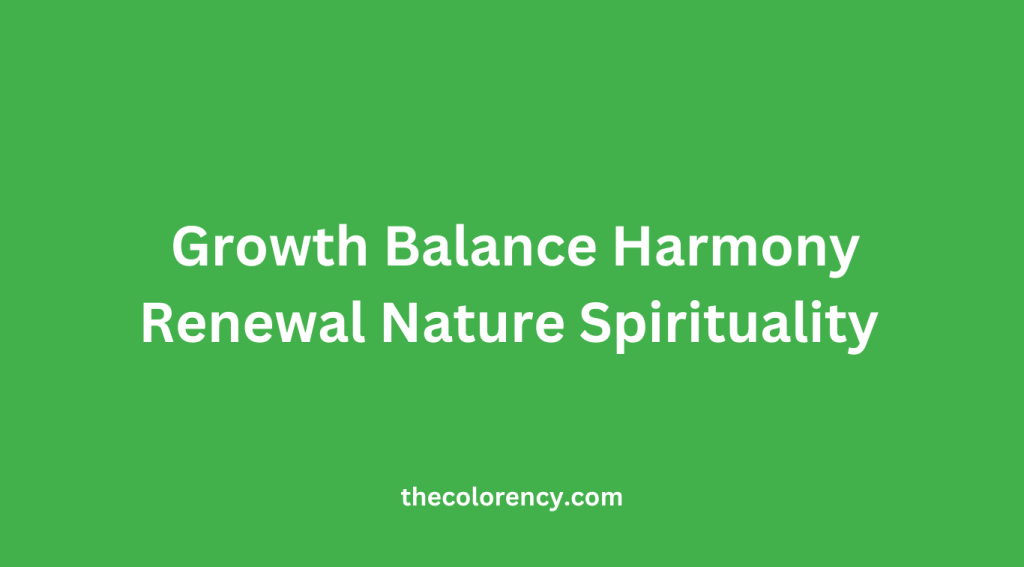
Green is a color that is abundant in nature and holds a special place in human history. From lush forests to blooming gardens, this color represents life, growth, and renewal. But beyond its aesthetic appeal, green is also loaded with symbolism and meaning. In this blog post, we will dive deeper into the meaning of green and uncover its significance in various contexts. Join us on this journey of discovery and let’s explore the wonders of green together.
Green is often associated with growth, renewal, and life. It’s also associated with nature, balance, harmony, and freshness.
The Origin of Green
Green is one of the oldest colors known to humanity. Its origins can be traced back to ancient cultures, where it was often associated with fertility, nature, and the cycle of life. The ancient Egyptians, for example, believed that green represented the rebirth of the sun and used it extensively in their art and architecture. The Greeks, on the other hand, saw green as a symbol of victory and used it to honor their athletes and heroes.
As time went on, the meaning of green continued to evolve. In the Middle Ages, it became associated with love and passion, while in the Renaissance, it was used to symbolize hope and optimism. Today, green is often seen as a symbol of sustainability, environmental awareness, and social responsibility.
Green Symbolism in Religion and Spirituality
Green also has a significant presence in many religious and spiritual traditions.
In Islam, the color green symbolizes sacredness and is often linked with paradise and the Prophet Muhammad.
Similarly, in Hinduism, the color green is associated with the heart chakra, representing the core of compassion and love.
In Buddhism, green is believed to represent balance, harmony, and spiritual awakening.
Green is also an important color in Christianity, where it is associated with resurrection, new beginnings, and eternal life. In the Bible, green is often used to describe lush pastures and fertile lands, which are seen as symbols of God’s provision and care.
The Psychological Impact of Green
Green is not just a color, it’s also a mood. This versatile color is known for its calming and soothing effects on the mind and body. In fact, many hospitals and healthcare facilities use shades of green in their decor to promote healing and relaxation.
Green is also associated with creativity, growth, and abundance. This is why it is often used in marketing and advertising, especially in industries related to health, wellness, and the environment.
However, green can also have negative connotations. In some cultures, it is associated with jealousy, greed, and envy. This is why it’s important to be mindful of the context in which green is used and to choose shades that evoke positive emotions.
The Meaning of the Color Green in Nature
Green is perhaps most commonly associated with nature, and for good reason. The color green is everywhere in the natural world, from verdant forests to rolling hills and sprawling meadows. It is the color of plant life, representing growth, vitality, and renewal.
Green is also a symbol of balance in nature. It is the color of chlorophyll, which is essential for photosynthesis and the production of oxygen. Without green, life on earth as we know it would not be possible.
How to Incorporate Green Into Your Life
Now that we’ve explored the meaning and significance of green, it’s time to incorporate it into our lives. Here are some tips for bringing the color green into your home, wardrobe, and lifestyle:
- Add potted plants to your home or office space
- Wear green clothing or accessories to promote feelings of balance and harmony
- Use green in your branding or marketing materials to evoke feelings of growth and renewal
- Eat more green fruits and vegetables
- Incorporate green into your workout routine by spending time outdoors in natural environments
- Choose eco-friendly products and make sustainable lifestyle choices to show your commitment to environmental responsibility
- Use green in your home decor to create a calming and soothing atmosphere
Conclusion

Green is more than just a color; it’s a symbol of life, growth, and renewal. It holds significant meaning in many cultures and traditions, and has a powerful impact on our emotions and wellbeing. By understanding the meaning of green and incorporating it into our lives, we can tap into its positive energy and harness its power to create a more balanced and harmonious world.
So the next time you see the color green, take a moment to appreciate its significance and all that it represents. Whether it’s the lush greenery of a forest or the vibrant hues of a fresh salad, green is a color that will continue to inspire and captivate us for generations to come.
